Everyone has heard of the functional alcoholic. This is the person who drinks excessively, who needs to drink every day to quell withdrawal symptoms, but who can also go to work, maintain relationships, and keep a home life that is fairly steady and balanced. Is it also possible to be a functional drug user? Is there a difference between a functional drug user and a drug addict? And how can you tell what is going on with your spouse?
The Functional Drug User
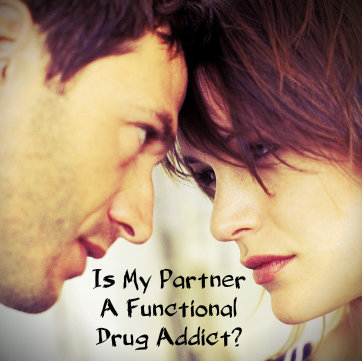 It is possible, at least for a time, for a drug user to be high functioning. If your spouse or partner uses drugs but still has a job, still meets your needs at home, still keeps up with responsibilities, and rarely experiences negative consequences related to drug use, your partner is functioning. Some of the most addictive drugs are difficult to use in such a way that functioning is still possible. For instance, heroin users are rarely functioning on any level other than a desire to get the next fix.
It is possible, at least for a time, for a drug user to be high functioning. If your spouse or partner uses drugs but still has a job, still meets your needs at home, still keeps up with responsibilities, and rarely experiences negative consequences related to drug use, your partner is functioning. Some of the most addictive drugs are difficult to use in such a way that functioning is still possible. For instance, heroin users are rarely functioning on any level other than a desire to get the next fix.
High-functioning drug users are more likely to be those that use marijuana, cocaine, prescription painkillers or amphetamines, or methamphetamine. If your partner uses drugs to get going in the morning, to relax after work, to cope with her emotions, particularly negative ones, or to get a boost of energy, she has a problem whether she is functioning or not.
Functioning And Addicted?
A functional drug user may not be an addict right away. If the drug use has not yet become compulsive or if your partner has not yet started to experience withdrawal symptoms, she may not yet be addicted. It is important to understand, however, that she is headed down a dangerous path.
If she continues to use drugs motivated by emotional reasons or the need to function during the day, she is headed down the path to addiction. Addicts can be high-functioning, and you may be watching your loved one gradually slide from casual drug use into addiction without noticing. The fact that she can function normally makes this transition difficult to catch.
Getting Help For Your High-Functioning Addict
It is very important for you and your partner to discuss her drug use. Whether you think she has become addicted or is still a casual user, she needs to stop using. Abusing drugs always carries the risk of addiction, no matter what her intentions are or how well she is functioning. No matter how strong-willed she claims to be about her drug use, it is possible that she will become dependent on her drug of choice.
Getting a functioning user to admit to having a problem is difficult. Denial runs deep in high-functioning addicts because they can always point to their lack of negative consequences to prove they don’t have a problem. If she lost her job, got in trouble with the law or was going broke feeding her habit, it would be easier to admit to having a problem.
Your job is to convince her that she is headed down a dangerous road, and that she may end up facing serious consequences if she keeps going; point to her motivations for using. Does she use drugs to cope with emotions she doesn’t want to recognize? Does she use because facing the day without drugs seems impossible? Does she need drugs to relax or to cope with stress? These are all the motivations of drug abusers and addicts. Help your partner to understand what she is doing and the possible harm it could cause in the long run.
Read About Functioning Addicts In The Media
Heavy drinking is a term used to describe a level of excessive alcohol consumption that steeply increases a person’s chances of developing alcohol use disorder (a condition which includes both alcohol dependence and non-dependent alcohol abuse). Fully 25 percent of all people who drink excessively meet the requirements for diagnosis of this condition. Heavy drinking can also increase the risks for other serious health problems. In a study published in 2013 in the journal Alcohol and Alcoholism, a team of Japanese researchers looked at the impact of heavy alcohol consumption on the risks for developing heart disease or diabetes.
What’s Considered Heavy Drinking?
According to guidelines issued by the National Institute on Alcohol Abuse and Alcoholism (NIAAA), the vast majority of people keep their risks for developing alcohol use disorder to a minimum when they limit both their daily and weekly alcohol consumption. As a rule, men minimize their risks when they consume no more than four drinks on a single day and 14 drinks in a single week. Women minimize their risks when they consume no more than three drinks on a single day and seven drinks in a single week. The NIAAA defines heavy drinking as any pattern of alcohol consumption that exceeds either the daily or weekly recommended amounts for men or women.
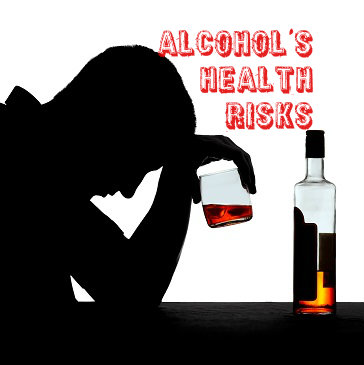 Heavy Drinking And Alcohol Use Disorder
Heavy Drinking And Alcohol Use Disorder
Twenty percent of all adults who drink heavily once a month develop alcohol dependence (alcoholism) or clinically diagnosable alcohol abuse. Thirty-three percent of all adults who drink heavily once a week develop one of these problems, while fully 50 percent of all adults who drink heavily twice a week become alcohol abusers or alcoholics. The definition for alcohol use disorder comes from the American Psychiatric Association (APA). The APA once considered alcohol dependence and alcohol abuse to be separate concerns. However, in recognition of the highly linked nature of the two conditions, the organization officially acknowledged them as aspects of a single disorder in 2013.
Heart Disease And Diabetes
Heart disease and diabetes are both relatively common, potentially fatal chronic health problems. Common forms of heart disease (also known as cardiovascular disease) include coronary artery disease, stroke and heart attack. Some people affected by the blood sugar disorder diabetes have an often-inherited condition called type 1 diabetes; however, most affected individuals have an acquired condition called type 2 diabetes. Among other factors, risks for both heart disease and type 2 diabetes are associated with a buildup of fat in the abdominal region and an increase in a type of blood-borne fat called triglyceride.
Risks Produced By Heavy Drinking
In the study published in Alcohol and Alcoholism, researchers from Japan’s Hyogo College of Medicine used an examination of 21,378 men between the ages of 35 and 60 to compare the levels of abdominal fat and triglyceride accumulation associated with abstinence from alcohol consumption, light alcohol consumption, heavy alcohol consumption and very heavy alcohol consumption. They performed this comparison in order to estimate some of the diabetes- and heart disease-related risks associated with drinking. The researchers defined light drinking as intake of less than 0.78 ounces of pure alcohol a day. They defined heavy drinking as intake of anywhere from 0.78 to 1.55 ounces of pure alcohol a day. They defined very heavy drinking as any level of intake above 1.55 ounces of pure alcohol a day. In the U.S., a single standard drink of alcohol contains 0.6 ounces of pure alcohol.
The researchers found that, compared to both non-drinkers and other drinkers, very heavy consumers of alcohol have significantly increased risks for developing the abdominal fat and triglyceride increases that can contribute to the onset of heart disease or type 2 diabetes. They also found that, compared to both non-drinkers and other drinkers, light drinkers have significantly lowered risks for this body fat and triglyceride accumulation. In addition, the researchers concluded that, compared to very heavy drinkers who exercise regularly and don’t smoke, very heavy drinkers who smoke and fail to get regular exercise have substantially higher chances of accumulating abdominal fat and triglyceride. Conversely, light drinkers who don’t smoke tend to accumulate abdominal fat and triglyceride considerably slower than light drinkers who do smoke.
The authors of the study published in Alcohol and Alcoholism also concluded that all four groups of participants (non-drinkers, light drinkers, heavy drinkers and very heavy drinkers) had substantially higher chances of developing high blood sugar levels (characteristic of diabetes) when they had increased levels of abdominal fat. This finding indicates that an accumulation of abdominal fat boosts the risks for type 2 diabetes even when an individual keeps his or her alcohol consumption within recommended daily and weekly amounts.
See How Alcohol Use Among Teens Has Changed Over Time And Learn The Risky Alcohol Behaviors
17 Dec 2013
Promises Austin Luxury Rehab
Promises Austin is a luxury rehab center just outside Austin, Texas that treats men and women ages 26 and older who are looking for the most advanced and effective treatment available for addiction and co-occurring mental health disorders. We are able to provide extraordinary personal attention and a superior staff-to-client ratio because we treat a maximum of 24 clients at a time.
Located on a private, nine-acre estate nestled in the scenic Texas Hill Country, Promises Austin is a Joint Commission-accredited luxury rehab. Our programs are comprehensive, customized, evidence-based and effective, encompassing everything from medical detox to 35- and 60-day addiction treatment programs. We provide personalized treatment plans that are designed to address our clients’ physical, mental, emotional and spiritual needs.
At Promises Austin, we recognize that depression, anxiety, trauma and other mental health issues often accompany substance abuse. Our team of experienced counselors, a physician, and 24-hour nursing staff addresses these underlying issues during rehab.

Unique Addiction Treatment Programs
What can you expect during your stay at Promises Austin? Our approach includes more than a dozen holistic and traditional therapies merged into one luxury rehab experience. Our goal is to help you heal. Our addiction treatment programs offer a variety of therapies including:
- Acupuncture
- Aqua Therapy
- Drum Circles
- Eye Movement Desensitization and Reprocessing (EMDR)
- Integrative Breathwork
- Expressive Art Therapy
- Labyrinth
- Massage Therapy
- Medicine Wheel
- Personal Training
- Psychodrama
- Recreation Therapy
- Yoga
When you come to Promises Austin, you enter a luxury rehab center that is part of the Promises nationwide family of addiction treatment facilities. This means that each and every client receives Promises excellence – our promise to you.
After you leave Promises Austin, having completed your personalized addiction treatment program here in Texas, you’re not thrust out into the world with no resources. Our goal is to help you achieve lifelong sobriety. To that end, we provide one year of recovery coaching with your primary therapist so that clients who have completed the Promises Austin residential addiction treatment program may return for additional support as needed within the first year – at no cost.
Discover what it truly means to heal out here in Texas, call us today and begin your journey to recovery and freedom from addiction!
13 Dec 2013
Why Has There Been A Sharp Increase In PCP Use?
The Substance Abuse and Mental Health Services Administration (SAMHSA) produces regular reports based on population groupings that track drug use trends in the United States. In a recent Drug Abuse Warning Network (DAWN) report, SAMHSA provided evidence of a sharp spike in PCP use.
Forms Of PCP
Phencyclidine, otherwise known as PCP or angel dust, is found in various forms, including crystal, capsule, tablet, powder and liquid. It’s often found in the form of marijuana and/or tobacco joint dipped in liquid PCP called a Sherm, which is named for Nat Sherman cigarettes. PCP first emerged in major U.S. cities in 1967, and by 1978 it was called the country’s number one drug problem on 60 Minutes.
PCP’s Recent Sharp Rise In Use
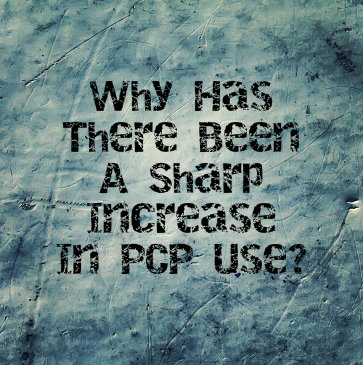 Its popularity had dropped significantly throughout the 80s and 90s until, according to SAMHSA, PCP-related emergency room visits rose 400 percent between 2005 and 2011, and actually doubled from 2009 to 2011, from 36,719 to 75,538.
Its popularity had dropped significantly throughout the 80s and 90s until, according to SAMHSA, PCP-related emergency room visits rose 400 percent between 2005 and 2011, and actually doubled from 2009 to 2011, from 36,719 to 75,538.
Dangerous Effects Of PCP
The hallucinogen is considered to be exceptionally dangerous because users can become extremely violent. Users report feeling detached from their surroundings, with dangerous side effects including seizures, irregular breathing and comas. PCP is also addictive and can result in high levels of anxiety and suicidal thoughts.
The most significant increase by age was demonstrated among adults aged 25 to 34, with a 518 percent increase from 3,643 visits to 14,175. In 2011 males comprised 69 percent of the 75,538 ER room visits and 45 percent of the visits were by adults between the ages of 25 to 34. PCP was combined with other drugs 72 percent of the time: with one other substance in 37 percent of ER visits, two other substances in 18 percent and 3 or more substances another 18 percent.
Public Education Needed On PCP’s Dangers
The study authors explained PCP’s resurgence using the term “generational forgetting,” meaning that what once was widely recognized as a dangerous drug is now resurging due to an uneducated public.
The authors recommend targeting 25- to 34-year-olds for education and prevention efforts, including tobacco and marijuana awareness due to the possibility of cigarettes and joints being laced with PCP.
The findings of SAMHSA reports are used by many groups: policymakers access the reports to ensure that adequate substance abuse treatment facilities serve their communities; law enforcement personnel can use the data to determine where their efforts need to be focused and learn which substances may be most dangerous in their area of service; the findings are also used in clinical settings to develop useful screening tools for patients in order to detect the use of other substances or the presence of additional mental health concerns.
There may also be a need for increased training efforts among emergency department personnel related to recognize the signs and symptoms of PCP use and the recommendations for treatment.
Read More About The Risks Of Meth And IV Drug Use
Buprenorphine is an opioid narcotic medication used to ease a reliance on stronger narcotics during recovery from active drug addiction. For specific reasons, doctors often combine the use of this medication with a secondary medication called naloxone. In a study published in November 2013 in the journal Addictive Behaviors, researchers from the State University of New York, Buffalo explored the reasons some people successfully complete buprenorphine/ naloxone treatment for opioid addiction, while others do not.
Dependence Risks Of Using Opioids
All opioid substances produce two primary effects when introduced into the human body: a highly pleasurable (euphoric) mental state and a significant reduction in the ability to feel pain. Doctors rely on the pain-relieving effects of prescription opioids to relieve serious forms of pain, but must constantly monitor the possibility for the onset of opioid dependence and the subsequent development of an opioid addiction. Since illegal or illicitly used opioids produce the same basic effects as suitably prescribed opioids, intake of these substances also comes with serious dependence and addiction risks.
How Buprenorphine Is Used For Addiction
 Buprenorphine is a significantly less powerful drug than the popular legal and illegal opioids of abuse. When an opioid addict switches over to buprenorphine use, he or she commonly experiences a reduction in euphoric and painkilling sensations, and also gradually reduces his or her level of physical dependence on narcotics in general. Doctors take advantage of these qualities by prescribing the medication during opioid addiction treatment. Instead of facing intense, potentially overwhelming symptoms of opioid withdrawal during the early stages of the treatment process, patients who switch over to buprenorphine typically avoid withdrawal and set themselves up for an increased likelihood of long-term addiction recovery.
Buprenorphine is a significantly less powerful drug than the popular legal and illegal opioids of abuse. When an opioid addict switches over to buprenorphine use, he or she commonly experiences a reduction in euphoric and painkilling sensations, and also gradually reduces his or her level of physical dependence on narcotics in general. Doctors take advantage of these qualities by prescribing the medication during opioid addiction treatment. Instead of facing intense, potentially overwhelming symptoms of opioid withdrawal during the early stages of the treatment process, patients who switch over to buprenorphine typically avoid withdrawal and set themselves up for an increased likelihood of long-term addiction recovery.
In the U.S., the manufacture and distribution of buprenorphine (and all other legal and illegal opioids) are regulated under a federal law called the Controlled Substances Act. This law specifically stipulates that doctors who give their patients buprenorphine during opioid addiction recovery must also either provide access to some sort of therapeutic counseling or direct their patients to other counseling resources. The counseling options most commonly offered to individuals receiving buprenorphine are a reward/punishment approach called contingency management (CM) and a gradual behavior modification therapy called cognitive behavioral therapy (CBT). However, in reality, not all buprenorphine recipients end up participating in a counseling program, even when they have access to such a program.
How Naloxone Is Utilized With Buprenorphine
Naloxone is not an opioid drug. In fact, it was originally developed as an anti-opioid medication, and has the ability to rapidly halt the effects of opioid intoxication inside the body. Doctors use the combination of buprenorphine and naloxone to reduce the chances that a person going through opioid addiction treatment will abuse buprenorphine instead of using that medication as directed. When the two medications are dissolved together under the tongue, enough buprenorphine reaches the bloodstream to help relieve opioid withdrawal; at the same time, the presence of naloxone limits buprenorphine’s impact and reduces its usefulness as a target of drug abuse. A prescription medication called Suboxone contains the proper proportions of buprenorphine and naloxone to achieve the desired treatment objectives.
Buprenorphine/Naloxone Opioid Addiction Treatment
In the study published in Addictive Behaviors, the SUNY Buffalo researchers used an examination of 356 opioid-addicted adults to explore the factors that contribute to the successful completion of addiction programs centered on the combined use of buprenorphine and naloxone. All of these adults were enrolled in a six-month treatment course that provided access to counseling resources. 127 of the participants successfully completed the course, while the remaining 229 participants did not.
After assessing the impact of a range of potential factors, the researchers concluded that the individuals who successfully completed a naloxone and buprenorphine opioid addiction treatment differed from those who did not complete treatment in two key ways. First, they took advantage of the counseling resources made available to them and established good records of counseling attendance. Interestingly enough, they also had histories of previous, significant physical injuries.
The authors of the study published in Addictive Behaviors don’t know for sure why prior experience of a physical injury increases the chances that an individual will complete buprenorphine/naloxone-based opioid addiction treatment. However, they do have a potential explanation. Previously injured people may have a history of exposure to chronic pain; in turn, use of buprenorphine during addiction treatment may help relieve that pain in addition to decreasing a reliance on the addictive effects of stronger opioids. It is the combination of withdrawal avoidance and ongoing pain reduction that may account for the link between prior injury and successful buprenorphine/naloxone treatment outcomes.
Read More About Opioid Related Disorders And Break Free From Addiction!
Alcohol consumption is illegal for all teenagers in the U.S. Despite this fact, significant numbers of teenagers drink, and therefore expose themselves to a range of health risks and social problems of alcohol. In a study published in October 2013 in the Journal of Child & Adolescent Substance Abuse, researchers from the Pacific Institute for Research and Evaluation looked at the way young, alcohol-consuming teenagers alter their drinking patterns as they grow older. These researchers found that most young teens manage to avoid any increases in alcohol consumption over time, while a small but significant minority of young teens experience either moderate or heavy increases in their consumption levels.
Alcohol Consumption Rates In Young Teens
 In collaboration with the University of Michigan, the National Institute on Drug Abuse tracks American teenagers’ level of involvement in substance use with an annual survey project called Monitoring the Future. According to results compiled from the 2012 version of this project, roughly 16 percent of all U.S. eighth graders consume alcohol at least once monthly. This rate follows a downward trend that first began in the mid-1990s.
In collaboration with the University of Michigan, the National Institute on Drug Abuse tracks American teenagers’ level of involvement in substance use with an annual survey project called Monitoring the Future. According to results compiled from the 2012 version of this project, roughly 16 percent of all U.S. eighth graders consume alcohol at least once monthly. This rate follows a downward trend that first began in the mid-1990s.
Figures gathered from Monitoring the Future also indicate that roughly 6 to 7 percent of all eighth graders in the U.S. participate in a dangerous form of consumption called binge drinking in any given two-week period. Binge drinking gets its name because participants binge on enough alcohol (typically, five drinks or more for boys and four drinks or more for girls) to become legally drunk in two hours or less.
Risky Behaviors Associated With Early Alcohol Consumption
Alcohol consumption has a strongly negative impact on teenagers, especially young teenagers below the age of 14, the National Institute on Alcohol Abuse and Alcoholism reports. Examples of the risks associated with drinking at this early age include higher rates of involvement in car crashes and other accidents, higher risks for homicide and suicide, higher rates for victimization in violent criminal acts such as assaults and rapes, increased chances of participation in disruptive conduct while in school, increased chances for poor academic results, an earlier onset of participation in sexual activity and increased risks for the practice of unsafe sex.
In addition, teen boys and girls who drink before the age of 14 tend to participate in binge drinking rather than moderate alcohol consumption. Critically, they also become alcoholics fully four times more frequently than people who don’t drink until they reach legal age.
Changes In Consumption Over Time
In the study published in the Journal of Child & Adolescent Substance Abuse, the Pacific Institute researchers looked at the ways in which young teenagers change their alcohol intake patterns as they grow up. The researchers also looked at the factors that help predict an increase in alcohol consumption among young teens. They undertook their project because only a few prior research groups had examined drinking patterns in this particular age group. All told, the study included 5,903 middle school teens. The researchers began tracking these teens when they were sixth graders and continued to track them through the eighth grade.
After completing the study’s primary phase, the researchers found that there are four emerging patterns of alcohol intake in middle school teenagers. Slightly less than 50 percent of all teens in this age group avoid drinking altogether or only drink on fairly rare occasion. Slightly more than 29 percent of all middle school teens initiate experimental alcohol use and continue to drink, but only increase their consumption levels to a minor extent over time. Fifteen percent of all middle schoolers start drinking significantly earlier than their alcohol-using peers, but still manage to keep their intake levels low. Slightly more than 6 percent of all children in this age group initiate alcohol use, and then fairly quickly begin consuming enough alcohol to rank as “heavy” drinkers.
Underlying Factors Of Teen Alcohol Use
The researchers concluded that the single biggest factor in forming any given young teen’s alcohol use pattern is his or her level of belief in the ability to control his or her rate of alcohol consumption. Young teens who believe they can control their drinking-related behaviors tend to do so, while those who don’t believe they can control their drinking tend to experience a spike in intake. Other factors identified as contributors to a young teenager’s alcohol intake pattern include the relative level of peer pressure he or she experiences for or against drinking, as well as the relative level of positive or negative feelings he or she has toward the effects and benefits of drinking.
Learn More About Detoxing From Alcohol And Gain Your Life Back!
10 Dec 2013
Are Current Drug Policies Really Not Working?
A report out of the United Kingdom highlights the widespread distribution of illegal street drugs, with the researchers calling the war on drugs a failure. The experts say it’s time to address drug use through a public health approach rather than as a criminal justice initiative.
Illegal Drugs – Stronger, Cheaper And More Readily Available
The study from the International Centre for Science in Drug Policy, which examined decades of drug surveillance data involving the trafficking of marijuana, cocaine and opiates like heroin, showed that illegal drugs are cheaper, purer and more available than ever.
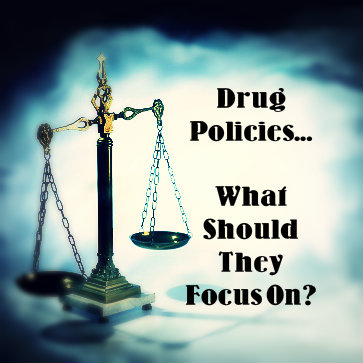 The findings highlighted the decrease of drug prices between 1990 and 2010, while purity and potency increased. In Europe the price of opiates and cocaine decreased by 74 percent and 51 percent during that time period.
The findings highlighted the decrease of drug prices between 1990 and 2010, while purity and potency increased. In Europe the price of opiates and cocaine decreased by 74 percent and 51 percent during that time period.
In addition, seizures of drugs increased during the study period. In most locations that were monitored the amount of cocaine, cannabis and heroin confiscated by law enforcement increased substantially during the years examined.
Should The Focus On Curbing Drug Use Shift?
The authors of the report note that the findings should be taken as an indication that current strategies to curb drug distribution are failing. However, despite these concerns, the focus for national governments has been law enforcement. Other approaches, such as decriminalization and legal regulation, have not been broadly incorporated.
Co-author Dr. Evan Wood, scientific chairman of the Centre, explained that the focus should shift to drug use as a public health concern rather than a criminal charge. Wood also talked about the need for increased addiction treatment availability and other public health strategies.
Just days before the findings were released, a senior UK police officer offered his opinion that decriminalization would be more effective than the current approach.
How Decriminalization Of Drug Offenders May Be A Positive Thing
Mike Barton, Chief Constable of Durham Police, voiced his position that drug users needed treatment and care, not criminal justice. Barton also said that decriminalization would threaten the motivation of dealers by taking away their income and power.
Instead, prohibition funds the drug dealers, says Barton, who is calling for an open debate that acknowledges the problems that still exist in the fight to reduce drug use.
Recovery Treatment Or Criminal Charges?
While the overall global strategy is prohibition, there are some national governments incorporating different policies. In Portugal individuals caught possessing drugs can avoid criminal charges if they undergo treatment.
While a more public health-focused approach seems clear to some in the scientific community, public officials have been less enthusiastic. No political party in the UK supports a legal regulation approach when it comes to hard drugs, but some politicians support legalizing marijuana.
Many recognize the delicate balance between treating drug use as a criminal justice issue and providing support for the recovery of the user. The community must be protected from the influence of the drug market, but the individual must be supported in their recovery, too.
Read More About Drug Use In The News
Crystal methamphetamine (crystal meth) is an illegal, illicitly produced form of methamphetamine, a tightly controlled stimulant drug with limited but real usefulness as a legitimate medication. People who use/abuse this illegal product run significant risks for developing a range of serious or potentially deadly health complications. According to the results of a study published in October 2013 in the Canadian Medical Association Journal, teenagers and young adults who use crystal meth substantially increase their chances of getting involved in IV (intravenous) drug use, a form of drug use strongly associated with severe substance-related health problems.
How Methamphetamine And Crystal Meth Effects The Body
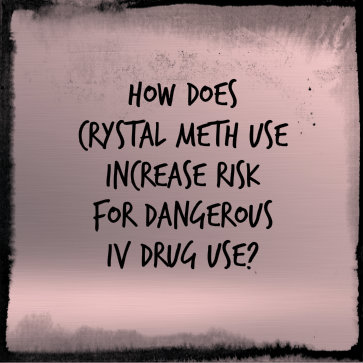 Methamphetamine is a close chemical relative of amphetamine; like that well-known stimulant medication, it produces euphoric sensations and sharply boosts the baseline activity rate inside the brain. Over time, the brain can get accustomed to methamphetamine’s effects and develop a dependence on the drug’s presence. In turn, dependence on methamphetamine is often a precursor for methamphetamine addiction, a highly disruptive and destructive combination of dependence, drug cravings and drug-oriented lifestyle patterns. Doctors occasionally prescribe legal, pharmaceutically manufactured methamphetamine to treat cases of narcolepsy, severe obesity or attention-deficit/hyperactivity disorder (ADHD).
Methamphetamine is a close chemical relative of amphetamine; like that well-known stimulant medication, it produces euphoric sensations and sharply boosts the baseline activity rate inside the brain. Over time, the brain can get accustomed to methamphetamine’s effects and develop a dependence on the drug’s presence. In turn, dependence on methamphetamine is often a precursor for methamphetamine addiction, a highly disruptive and destructive combination of dependence, drug cravings and drug-oriented lifestyle patterns. Doctors occasionally prescribe legal, pharmaceutically manufactured methamphetamine to treat cases of narcolepsy, severe obesity or attention-deficit/hyperactivity disorder (ADHD).
Crystal meth gets its name from its characteristic crystalline appearance. In America, most of the available supply of this drug comes from illegal, large-scale manufacturing facilities located on U.S. territory or in other countries. Some crystal meth also comes from small-scale operations that only service local areas. Depending on the process used during its creation, illegally made methamphetamine can contain a number of highly dangerous compounds, including sulfuric acid, acetone, hydrochloric acid or red phosphorus. Since use of crystal meth inevitably takes place outside of a legitimate medical context, it inherently constitutes a form of drug abuse. People who habitually use the drug have exceedingly high risks for developing an addiction or other major health problems such as drug overdoses, disturbed or violent mood shifts, extreme tooth and gum damage (meth mouth) and psychosis (hallucinations and/or delusional thought processes).
IV Drug Use
IV drug use is the common term for the purposeful injection of drugs directly into the bloodstream. As a rule, doctors and other medical professionals use this term in reference to the injection of recreational substances rather than medications. IV drug abusers commonly rely on direct bloodstream access to rapidly deliver substances to their brains, and thereby rapidly trigger the effects associated with those substances. IV drug injection carries risks above and beyond the risks classically associated with recreational drug use in general.
IV Drug Use Risks
- Increased chances of drug overdose
- Dangerous or lethal infections such as hiv/aids or hepatitis b or c
- Lethal infection-related complications such as bacteremia or sepsis
- Increased chances of developing pneumonia
- And increased chances of dangerous contaminants or additives
How Crystal Meth Use Increases Chance Of Falling Into IV Drug Use
In the study published in the Canadian Medical Association Journal, researchers from several Canadian institutions used information gathered from a project called the At-Risk Youth Study to examine the potential connection between crystal meth use and the initiation of IV drug use among teenagers and young adults between the ages of 14 and 26. All told, 991 individuals submitted answers to questionnaires regarding their baseline drug-using behaviors. At the beginning of the study, 395 of these individuals were crystal methamphetamine users, while another 390 were IV drug users. The researchers tracked the drug use patterns of all 991 participants over five years in order to uncover any developing trends.
Altogether, 16 percent of the participants not initially involved in IV drug use began taking drugs intravenously over the course of the study. After analyzing their data, the researchers found that the recent use of a non-injectable form of crystal methamphetamine is clearly linked to increased chances of beginning IV drug use. In most cases, prior users of non-injectable crystal meth choose this drug for their first forays into intravenous use. The researchers also found that the average young user of crystal meth who initiates IV drug intake makes the transition to intravenous use at the exceptionally early age of 14.
Meth Treatment Significantly Needed In City, Street Culture
The authors of the study published in the Canadian Medical Association Journal gathered their data from young people either living on the street or heavily involved in local street culture. They believe that their findings indicate an urgent need to address crystal methamphetamine use in this population and curb the transition to IV drug use.
Read More About The Connection Between Hepatitis C And IV Drug Users And Get Help Today!


